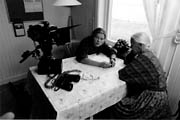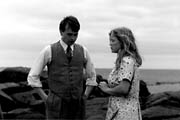|
NB. Unable to locate a copy of the original screenplay before the interview
took place, Marianne Olsen Ulrichsen kindly sent me the following notes about
the initial conception of the film:
No, I did it afterward. Actually, I had the idea for the script during my last year at film school, but it wasn't accepted as a good enough basis for the final work. So I dropped the idea, I didn't fight to do it at that point. I left it, but I couldn't forget it. Maybe a year or two later, I started rewriting it. I wrote and wrote, and then showed it to a friend who was working in the film business, and he said: "I think you should try and apply for money." I hesitated. I had lost some confidence when the head teacher told me: "No, this is not good enough." So then I took some time to think over whether or not I believed in it and should go ahead with it. I couldn't just forget it and put it away, so I sent it off and I got money to do it. In your letter, you told me about the original beginning of the story. This was my first script. I was afraid that the content of the story was too thin so I elaborated on and extended the original plot. This resulted in a loss of focus of the ideas central to the original story. In the extended script, the woman ended up having three flashbacks. The first is the one that's in the film. In the second one, she tries to leave the man, and in the third one, she sees her husband involved in an accident while at work and she fears he has been killed. So the story had become much longer and more complex. I realized that having the three flashbacks weakened the story. I think it comes down to: what is it I really want to tell. I tried to solve too many problems in one little film and that just doesn't work. You also wrote that you eliminated the establishing shots - the wide shots of the house and so on - so that the story could get moving more quickly. Then you added: "But I'll always have doubts about cutting away most of the non-action shots." Why is that? What do you see as their function in the film? Some yearilm, but what I'm most interested in is not to give ready-made answers. However, I like the complexities of human relationships and the difficulties we have in dealing with our emotions. For example: when you read a book, the most exciting thing is when the message can be found not so much in the actual written words and actions but between the lines and left to the reader to explore as the story evolves. I intended to achieve a similar experience for the audience by using non-action shots. And in Come, maybe what happened was that the characters became too much of an instrument to fulfill the story. And that observation of human complexity is not present on the screen. I think you're too critical of your own film, because the interactions in Come are so subtle. I wouldn't change one frame. Thank you... But I think when you have an original idea, and during the production process, you have to kill some of your darlings, there will always be a doubt if it doesn't turn out completely the way you wanted: is it because the idea didn't work, or could I have done something different and gotten out of it a result that was closer to my original intention? Just before the main flashback starts, we see the old woman looking down (at the watch). In the first moments of the flashback, the young girl is also looking down, and then looks up. The transition between the two is made very smooth by this matching of the direction of their gaze. Was that deliberate or did it just turn out that way? No, it was deliberate. The deliberate thing about it was that I wanted the characters' focus to be the same. She has changed. All people change as they grow older. But some things never change. Therefore some of the personal attributes of the two characters had to be portrayed as similar.
I also had a lot of other matching shots like that, but they didn't work. For example, before you see the woman's face, you see her legs walking slowly. And both her stockings are curled down. And when you see the first shot of the girl, one of her stockings is curled down too. I had more details like that which worked well in a literary sense but not in the film. The watch plays a very important role in the story - it binds the present to the past, the woman to the man (both in their younger and their older versions). When I show your film to my students, one of the things I point out is your use of an object which is invested with great meaning. Would you agree that in general, it's a good idea to let an object tell part of the story in a short film? I think it's very difficult because for many people, for example, a watch is an over-used symbol. So the balance is very difficult and I was a bit afraid of it, afraid that it would carry too many connotations, you know: "time passes," etc. The danger of using overexposed symbols is that they become a cliché. But when it works, I really like it. My grandmother had certain objects, and I could see her face and her whole behavior change when she touched them. It's touching the object, not just looking at it that counts - i.e., the connection between the person and the object. Was your grandmother the inspiration for the story? Yes. Was it in any way biographical? No. She's dead now. She used to tell me stories about her love life and she was very active when she was young. That was not normal at the time. She said no to a lot of her father's demands. He wanted her to get married. He gave her brothers support for their education but not her. She taught me that if you want something, you have to go and get it. But you have to be smart. She said: why should I be hunted, I want to be the hunter. That's one of the things that I like best about your film: your main character knows what she wants and she gets it. She's not a passive character. And that's also very important to me, because in a lot of stories, the female characters are often reacting to men's actions, or their problems are because of men, not because of what they choose to do or what they want to get or don't get. I wanted to show a girl who believed in love and was romantic but still strong. Early in the flashback, the young girl looks out at the other young people playing. And in one of those shots, there's a girl being carried, teased by a bunch of boys, who make believe they're going to drop her into the fire. In a way, that's the exact opposite of the role that your main character plays. There's one girl - the main character - who makes her own story, and there's another one who is trapped inside a man's story. Is that something that you consciously thought about? Well, that whole thing with the girl in the coffin, in the box, it was kind of improvised... I was looking for action that showed that my main character was different.
But the main character goes ahead anyway. It's your younger sister who plays the main role, isn't it? Yes. I think she does such a wonderful job. There are moments when she is looking at the boy, and she does something with her mouth - savoring what was to come. It's wonderful. Is that something that she thought of, or did you tell her to do that? No, I didn't tell her. I had never worked with actors before. And I knew that to me, it was important to have the security of knowing the person playing the main character. I knew that when we worked together, I would be able to tell before it happened whether her acting was becoming stiff, because I knew her intimately. We didn't talk much about what she was actually going to do. We found the framework and then it was up to her to develop the character from her own understanding. In a way, you trick the viewer into thinking that the old woman is alone, that she has lost her husband. Then you show us that the husband is still there. I assume that this was a deliberate strategy on your part. Did you know, when you first wrote the story, that he would be there at the end? Yes. I knew the beginning and the end. That didn't change. So it's sort of to give the viewer an unexpected reward, that there's this happy surprise at the end? Yes. I also tried to have some more intimate scenes with the old couple. But I realized that saying less leaves more to the imagination. In that connection, let me ask a stupid question: when the old woman says "Come" at the end, is she calling her husband to bed? Yes, she is. Your choice of music was also perfect. Do I remember correctly that there are two kinds of music? There's the music when the people are dancing, and then there's another music when they're alone in the cabin? Can you tell me anything about your choice of the music? Actually, the guy we see playing the accordion is an old fisherman at home where I come from. I remember him from the time I was young. He was an excentric guy. He never felt he fitted in with the well-to-do, cultural people, but he used to play on occasions when people gathered together. When he started playing, his whole attitude changed. He was just wonderful. His special integrity and authenticity were expressed through his music.
The other music I heard at a festival in Oslo, and the composer was playing down at the harbor. I walked past and I stopped and thought: this music is so visual, and evokes the elements (air, water, etc.). And I knew it would be the right music for my film.
At this stage, so many years later and wiser, I am somewhat ashamed of the naiveté of the film. The message that love can survive everything, that a long lasting love relationship is achievable, was what I wished to put across and wanted to believe in myself. I realize today that this is a reality for very few, but most of us look for this "lasting love." I fear it has become something of a cliché. I spent a lot of time thinking about what many people would call clichés, and the challenge is to explore them and to tell them in a new way to make them real again.
Is there any advice you would give student filmmakers who are working on their own short films? I've learned that it's very important to have people around you - not necessarily people who are very well educated about film - but people you have a good dialogue with and people that you trust... Don't be afraid to express your personal experiences and views of the world through your scripts and stories.
27 May 1998
|





